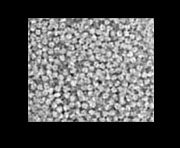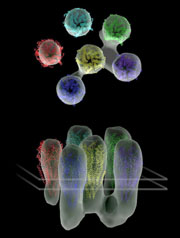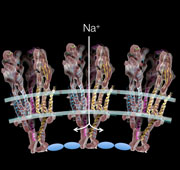Rapsyn
The neuromuscular junction mediates fast synaptic transmission between nerve and muscle cells, using the chemical transmitter acetylcholine (ACh). When a nerve impulse reaches the nerve terminal, ACh is released into the synaptic cleft. Almost instantly, it binds to and opens ACh receptor channels on the surface of the muscle cell, depolarising the postsynaptic membrane and causing the muscle to contract. The ACh receptors lie directly opposite the active zone where ACh is released, and must pack together tightly to deliver the maximum postsynaptic response.
The intracellular protein, rapsyn, contributes to the tight packing by forming dimers which bridge neighbouring receptors at their bases. Cryo-electron tomography and subtomogram averaging of Torpedo postsynaptic membranes shows that rapsyn dimers bind to each receptor at up to three distinct sites. This is the minimum number of sites required to form a two-dimensional network. The interconnecting rapsyn-receptor network lies underneath the intracellular entrances of the channels, leaving unrestricted sub-membrane space for ions to diffuse.
Key publication:
Zuber, B. and Unwin, N. The structure and superorganization of acetylcholine receptor-rapsyn complexes. Proc. Natl. Acad. Sci. USA 110, 10622-10627 (2013). (pdf)



